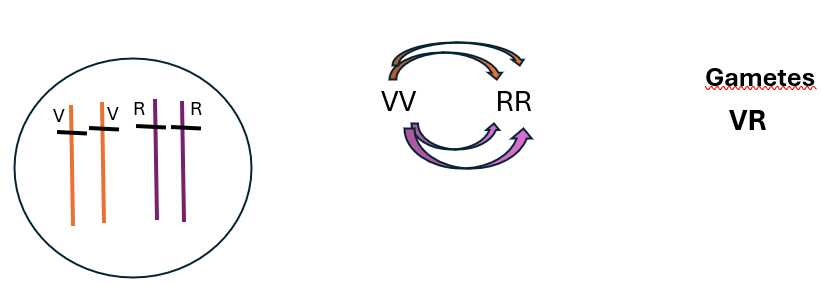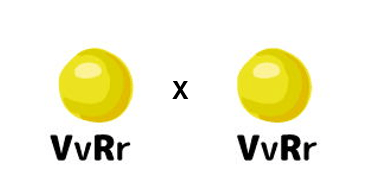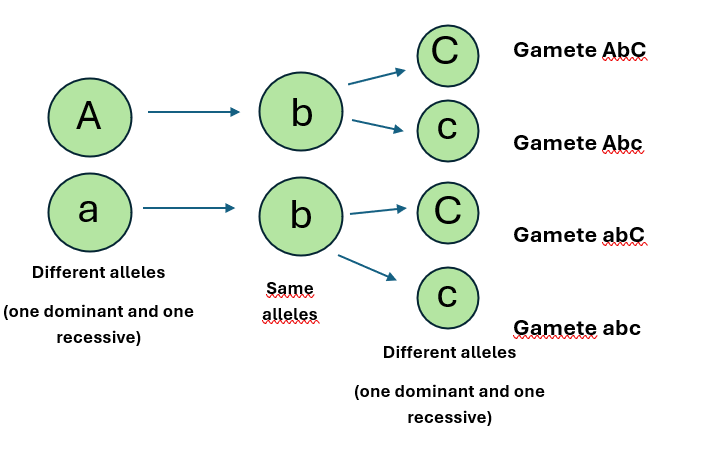In this article, we will continue with Mendel’s Laws by analyzing Mendel’s second law, also known as the Law of Independent Segregation. Unlike the first law, Mendel’s second law studies two or more traits simultaneously. For example, what would be the result of a cross between a plant with yellow, rough peas and a plant with green, smooth peas? In other words, in the simple example above, we can see that Mendel addressed two characters simultaneously, the color and texture of the peas, and proceeded to analyze Mendel’s second law, also known as the Law of Independent Segregation.
In this second law, Mendel integrated several characteristics simultaneously in order to see if the fact that an individual possessed a certain characteristic would influence the presence of another characteristic. For example, would the fact that a pea is yellow increase the likelihood of it being smooth? Or would it increase the likelihood of it being rough?
Mendel’s second law was possible because Mendel ended up selecting genes that are on different chromosomes, which are on different pairs of chromosomes.
Let’s consider the following examples:
First Example

Fig. 1-Homologous chromosome pairs, VV and RR, respectively. Both with dominant alleles (left image). During the formation of the gametes, a process of Independent Segregation takes place, a process of recombination between chromosomes (central image). The gametes resulting from this process can only be VR (right image), i.e. dominant for both characteristics.
In this first example, we can see that we have homologous chromosomes, i.e. chromosomes that carry the same alleles. We have a pair of homologous chromosomes containing the dominant V gene and another pair containing the dominant R gene. Consider that each allele in the pair comes from a parent.
When gametes are formed in meiosis, there is a process of recombination between chromosomes, called Independent Segregation. We can consider that VV corresponds to one characteristic and RR to another. The gametes produced can only be VR, i.e. for doubly homozygous individuals there is only one possible gamete, in this case VR, i.e. dominant for both characteristics.
Mendel Second Law Example

Fig. 2- Representation of Heterozygous individuals, with pairs of Vv and Rr chromosomes respectively, each chromosome carrying a different allele (right image). A clear example of Di-Hybridism, with one dominant and one recessive allele in each pair. Independent segregation process during gamete formation (middle image). The gametes resulting from this process can be of 4 different types (right image).
In this second example, we’ll see what happens in individuals who are heterozygous for both characteristics. Looking at the chromosomes, we can see that we no longer have homologous pairs, i.e. each chromosome carries a different allele. We have heterozygosity for both genes, which is called double heterozygosity. We can also call this situation Di-Hybridism1, where we have one dominant and one recessive allele in each pair. We can see from the example above that a Di-Hybrid individual can have 4 different gametes.
As Mendel’s Law applies to two or more simultaneous characteristics, when we are dealing with a considerable number of characteristics, in order to know the number of different gametes that an individual produces, we use a rule. The rule used is 2n, where n is the number of heterozygous pairs.
Let’s consider example 2, we can see that we have two pairs of heterozygotic alleles, Vv and Rr, in this case n=2. So the number of gametes will be 4 (22).
Considering the first figure, both pairs of alleles are homozygous. Therefore, n0=1.
Let’s review one of the crosses established by Mendel, in which two simultaneous characteristics were studied, the Color and Texture of Peas.
Mendel Law: Mendel’s Experience With Peas
It is important to note that with regard to the Color characteristic, we have the following situations:
- A Yellow Pea, since it is a dominant character, will have in terms of factors VV or Vv (V_).
- A Green Pea, since it is a recessive character, will have in terms of vv factors.
With regard to the Texture characteristic, we can have the following situations:
- A Smooth Pea, since it is a dominant character, will have, in terms of factors, RR or Rr (R_).
- A wrinkled pea, since it is a recessive trait, will have rr factors.
In a first cross, Mendel crossed pure organisms, or that is, when crossed with organisms that have the same characteristics, the offspring will also have those same characteristics. We have a pea that is yellow and smooth (VVRR) being crossed with a pea that is green and rough (vvrr). These organisms make up the so-called parental generation (P).

Fig. 3- Cross Between Pure Parents
VVRR (smooth yellow pea) and vvrr (rough green pea), correspond to the respective genotypes of the organisms involved in the cross. Consequently, the gametes formed for the VVRR genotype can only be VR. Gametes formed for the vvrr genotype can only be vr.
Let’s establish the cross between the gametes next:

Fig. 4- Crossing Between Parental Gametes. 100% of F1 individuals have VvRr Genotype
We can see that 100% of the organisms in the F1 generation have the VvRr genotype. In other words, this also means that 100% of the organisms have a yellow phenotype (Vv) and are smooth (Rr).
As with Mendel’s first law, Mendel subsequently back-crossed F1 individuals. In other words, Mendel crossed individuals belonging to the same generation. Therefore, the next cross was established between yellow and smooth peas, however, unlike the parental generation which are pure individuals, these are not. They are not pure, because they are heterozygous (VvRr).

Fig. 5- Second Law Of Mendel: Backcrossing between F1 individuals (Source: TodaMatéria)
Before establishing the cross, let’s check which gametes are formed. We can see that the possible gametes formed in each individual of the F1 generation can be: VR, vR, Vr and vr. Meaning, there are 4 possible gametes for each F1 hybrid individual. Let’s now establish a cross between F1 individuals.

Fig. 6- Mendel’s Second Law: crossing between gametes of the F1 generation. Respective genotypes of the F2 generation
F2 Generation
From the previous cross between F1 individuals, we obtain the F2 generation. The table above shows all the genotypes obtained from this cross. By analyzing each genotype, we can establish the phenotypes of the F2 generation, where we have:
- Yellow and smooth peas → 9 individuals (9/16)
- Yellow and wrinkled peas → 3 individuals (3/16)
- Green and smooth Peas → 3 individuals (3/16)
- Green and wrinkly Peas → 1 individual (1/16)
This means that the proportion of F2 phenotypes obtained will always be 9:3:3:1. Rough green peas are the result of a recessive homozygote and are therefore more difficult to occur.
As we have seen, Mendel’s second law can cover 2 or more characteristics simultaneously. When an analysis of the inheritance of 2 combined traits is established, as in the previous study, we can consider that we have a case of Dihybridism. When the analysis of the inheritance of 3 or more combined traits is established, we have a case of Tri-Hybridism and Poly-Hybridism respectively.
In a case of polyhybridism, determining the number of gametes that can be generated may seem like a more complicated process than the one described above. However, there are formulas and methods that allow us to calculate the number of gametes, as well as the type of gametes formed.
As previously mentioned, to calculate the number of gametes formed, we use the formula 2n, where n is the number of heterozygotic pairs.
Example: let’s consider an individual AabbCc.
- The number of gametes formed → 2n= 22 = 4
As well as knowing the number of gametes that a given individual gives rise to, we can also check which gametes have been given rise to using the Branching Method.
The Branching Method
The branching method is based on the separation of different allele genes. Each of these alleles is combined with the next pair. In the end, the Ramification lines are followed, which make it possible to relate the genes and check which types of gametes have been formed2.
Example: let’s see what types of gametes are formed in an AabbCc individual.

Fig. 7- Example Individual branching method AabbCc
AbC, Abc, abC and abc are the different gametes that this polyhybrid condition can generate.
With all these examples, you can certainly see the origin of genetic variability in populations. It is indeed an important law for understanding Heredity, as well as Evolution in populations. Although Mendel didn’t discover chromosomes and alleles himself, his experiments proved to be an important pillar in biology, making it easier to understand the patterns of genetic transmission3.
Footnotes
- The law of Independent assortment. (n.d.). Retrieved March 30, 2025, from https://faculty.ksu.edu.sa/sites/default/files/lecture_9_genetics-_the_law_of_independent_assortment.pdf ↩︎
- CAPÍTULO 3 -P.47 -SEGUNDA LEI DE MENDEL. (n.d.). Retrieved March 30, 2025, from https://professoraleonilda.wordpress.com/wp-content/uploads/2014/04/3capitulo-3-segunda-lei-de-mendel.pdf ↩︎
- Video From Biologia com Samuel Cunha ↩︎
Thank you for reading. If you’re curious and want to learn more, go to the “articles” section. Every week there are new articles published and new curiosities, stay tuned! Subscribing to our Newsletter will notify you when a new article drops.
Read Next
